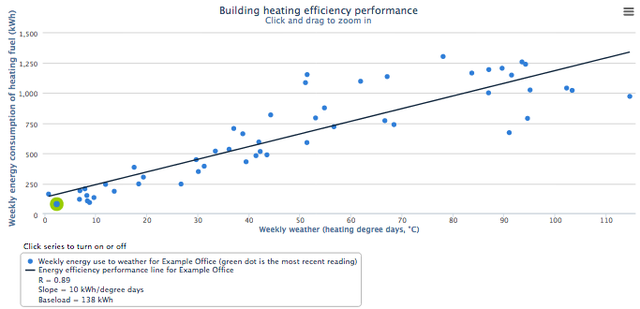Understanding heating consumption versus non-heating consumption
To analyse your energy consumption and distinguish between heating and non-heating uses, navigate to: Results > Weather Efficiency > Efficiency Chart. This graph illustrates how outside temperature influences your energy use, showing increased consumption during colder weather.
Performance Line and Baseload Energy Consumption:
The black line on the graph, known as the performance line, represents your expected energy use. Where this line intersects the vertical axis (y-axis) indicates your non-heating energy use, referred to as baseload energy consumption. Baseload energy consumption includes energy used for lighting, cooking, hot water, and running electrical appliances. It remains relatively constant over time and is not affected by weather fluctuations.
Heating Energy Consumption:
Any energy used beyond the baseload is for heating purposes and varies with outside temperatures. This additional energy consumption is directly related to the need to maintain a comfortable indoor temperature during colder weather.
Comparing Heating vs. Non-Heating Energy Consumption:
To compare heating energy consumption with non-heating energy consumption for a specific week, evaluate the ratio of baseload to total consumption. Subtract the baseload from the total consumption to isolate the energy used for heating. This comparison helps in understanding the proportion of energy spent on heating relative to other uses, enabling better insights into energy efficiency and potential areas for reducing energy spend.

Deep-Dive: Importance of Understanding Heating Consumption vs. Non-Heating Consumption in Your Energy Management Program
Optimising Energy Efficiency: Understanding the breakdown of heating vs. non-heating consumption is crucial for optimising energy efficiency. By identifying how much energy is dedicated to heating compared to other uses, you can:
- Target Improvements Focus on areas with the highest potential for energy savings. For example, if heating consumes a large portion of your energy, improving insulation or upgrading your heating system can significantly reduce energy use.
- Implement Efficiency Measures: Apply specific strategies to different types of energy use. For heating, this might include installing programmable thermostats or enhancing building insulation. For non-heating uses, strategies could involve upgrading to energy-efficient appliances and lighting.
Managing Energy Spend: Understanding your energy consumption patterns helps in managing and reducing your energy spend:
- Cost Allocation: Accurately allocate energy costs to different activities (heating vs. non-heating). This helps in budgeting and identifying cost-saving opportunities.
- Energy Procurement: Optimise energy procurement strategies based on usage patterns. For instance, if heating demands are high in winter, negotiate better rates or explore alternative energy sources for those periods.
Improving Energy Performance: Understanding heating vs. non-heating consumption is key to assessing and improving overall energy performance:
- Benchmarking: Compare your energy performance against similar buildings or historical data. Knowing the proportion of energy used for heating helps identify deviations and areas for improvement.
- Performance Metrics: Develop precise performance metrics. By isolating heating energy use, you can measure the effectiveness of specific energy efficiency initiatives, such as insulation improvements or heating system upgrades.
- Seasonal Adjustments: Make informed decisions on seasonal adjustments. For example, increase focus on heating efficiency during colder months and shift to optimising non-heating energy use in warmer months.
Enhanced Reporting and Compliance: Accurate differentiation between heating and non-heating consumption supports compliance with energy regulations and enhances reporting:
- Regulatory Compliance: Meet regulatory requirements by providing detailed and accurate energy use reports.
- Transparency: Improve transparency in energy reporting, building trust with stakeholders and demonstrating commitment to energy efficiency.
Conclusion
Incorporating the understanding of heating vs. non-heating consumption into your energy management program is vital for:
- Optimising energy efficiency and reducing energy spend
- Improving overall energy performance
- Supporting compliance and enhancing reporting transparency
By leveraging this information, organisations can develop targeted strategies, make informed decisions, and achieve significant energy and cost savings.
The following FAQ’s may help you further understand your performance and results with Pilio energy software:
- Heating Degree Days (HDD) and the Weather
- Comparing energy efficiency, cold winter versus mild winter
- Predicting your energy use
- Exporting charts and tables
- About Pilio weather data
- Historic degree day data
- Why is it important to look at energy use in relation to the weather
- Weather corrected energy consumption in context
- Interpreting building efficiency
- Using the Degree Days chart